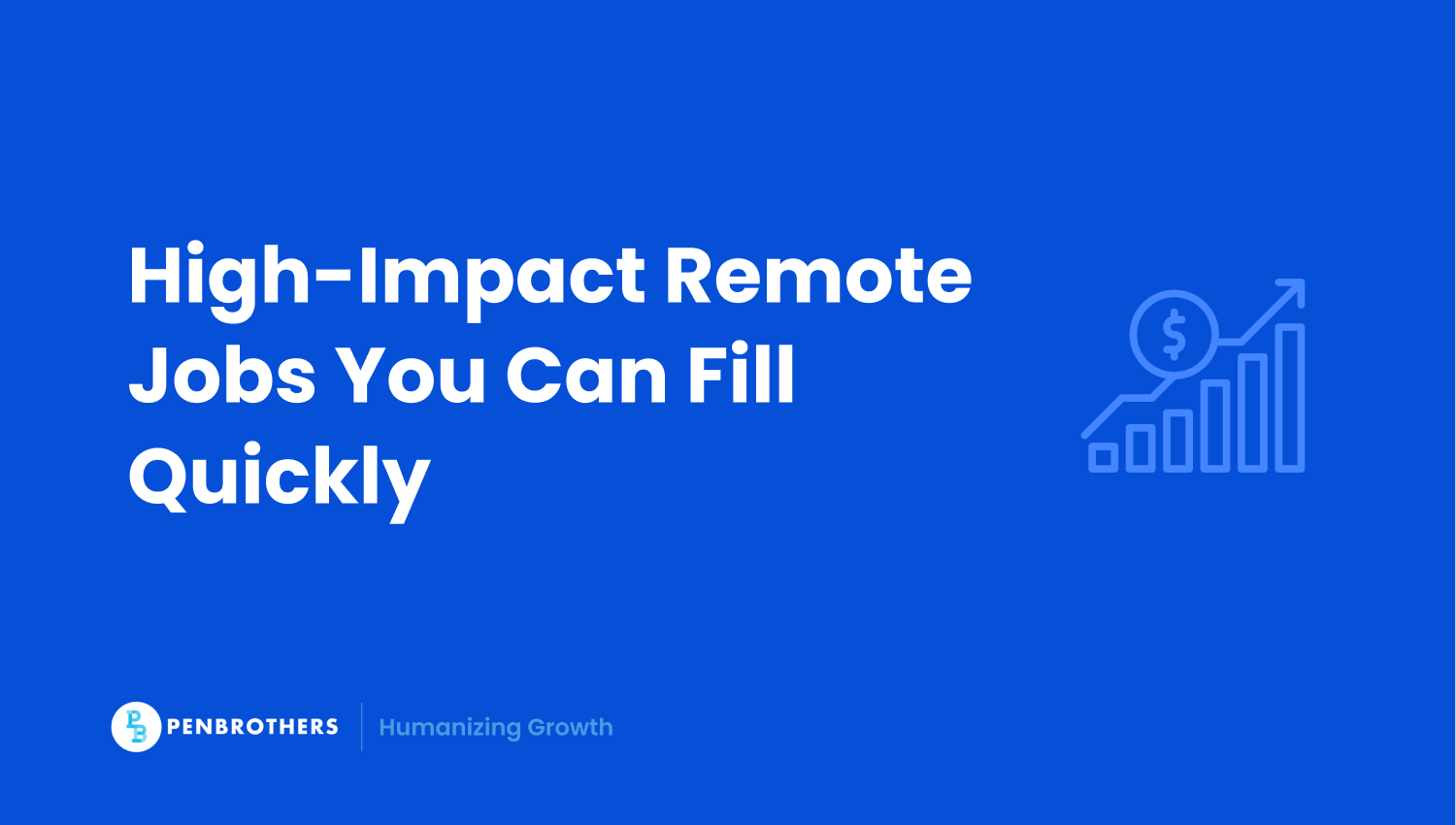What's Inside?
13 Easy Remote Jobs That Power Business Growth

When people hear “easy remote jobs,” they often imagine roles that are low-skill or low-impact. But in reality, these jobs are the silent engines that keep your business running smoothly while your core team focuses on strategic growth.
Easy remote jobs aren’t necessarily simple, they’re low-friction. They come with:
- Fast onboarding
- Clear processes
- Measurable outputs
- High offshorability
Delegating them frees up founders and managers drowning in operational noise. More importantly, it introduces leverage: hiring a customer support rep or a content creator can directly boost retention, sales, and visibility without the time and cost of building an in-house team.
What Makes a Remote Job Easy (for You) and Valuable (for the Business)
Not all remote jobs are created equal. Some require intensive onboarding, real-time collaboration, or constant oversight. Others, however, are low-friction and high-leverage, the kind of roles that integrate into your team with minimal disruption and immediate impact.
In a business context, an “easy” remote job is not about simplicity but efficiency. It’s a role that checks five key boxes:
- Fast to onboard: The role requires little to no ramp-up time. With clear instructions and basic tools, the person can start delivering value within days.
- Process-friendly: The work involves structured, repeatable tasks or well-defined deliverables. You can plug it into a workflow without reinventing the wheel.
- Cost-efficient: These roles can be sourced offshore, where high-quality talent is available at significantly lower cost, unlocking budget efficiency without sacrificing quality.
- High ROI: The job directly supports business-critical areas such as customer service, content production, or internal operations, delivering tangible outcomes without high investment.
- Low dependency: These roles don’t require constant supervision, deep collaboration, or access to sensitive systems. They can operate independently, with async check-ins and documented processes.
Because these jobs don’t rely on deep institutional knowledge, they are ideal candidates for remote and offshore hiring. With the right tech stack and process documentation, you can slot them into your business without slowing anything down.
13 Easy Remote Jobs That Drive Business Results
Each of these roles is both easy to fill and highly impactful when done right.
Each of these roles is both easy to fill and highly impactful when done right.
- Virtual Assistant
A VA frees up leadership to focus on high-impact tasks by taking over calendar management, inbox sorting, meeting notes, and travel booking. Tools like Google Workspace, Calendly, and Slack help streamline coordination.
| Philippines Annual Salary: | USD 15,120 |
| United States Annual Salary: | USD 55,900 |
- Customer Support Representative
Ideal for increasing retention and customer satisfaction, support reps handle live chat, email tickets, and returns or refunds. Platforms like Gorgias, Zendesk, and Intercom power these interactions. Expect to pay $600 to $1,200/month offshore.
| Philippines Annual Salary: | USD 11,700 |
| United States Annual Salary: | USD 54,000 |
Explore more about remote customer service jobs.
Build your SEO and brand authority by outsourcing blogs, newsletters, and landing pages. Writers use tools like Google Docs, Surfer SEO, and Grammarly.
| Philippines Annual Salary: | USD 16,900 |
| United States Annual Salary: | USD 78,000 |
- Social Media Manager
Grow your brand without taxing your internal team. Social media managers schedule content, respond to comments, and handle reporting using platforms like Buffer, Hootsuite, and Canva.
| Philippines Annual Salary: | USD 24,050 |
| United States Annual Salary: | USD 96,000 |
- Graphic Designer
A designer ensures visual consistency across sales, social, and marketing materials. Using Canva, Adobe Suite, or Figma, they create banners, infographics, and email visuals.
| Philippines Annual Salary: | USD 18,850 |
| United States Annual Salary: | USD 78,000 |
- Project Coordinator
This role keeps remote teams aligned by tracking tasks, preparing meetings, and updating progress. With tools like Asana, Trello, and Notion, project coordinators support operational flow.
| Philippines Annual Salary: | USD 27,300 |
| United States Annual Salary: | USD 108,000 |
- Sales Development Rep (SDR)
SDRs help fill your pipeline by handling cold outreach, lead research, and booking calls. Using HubSpot, Apollo, or LinkedIn, they take sales pressure off founders.
| Philippines Annual Salary: | USD 17,550 |
| United States Annual Salary: | USD 78,000 |
- Online Tutor / Trainer / Onboarding Assistant
Whether training new employees or onboarding clients, these specialists run process walkthroughs and training calls via Loom, Zoom, or Thinkific.
| Philippines Annual Salary: | USD 10,200 |
| United States Annual Salary: | USD 63,000 |
- SEO Assistant
Boost your organic visibility with keyword research, metadata updates, and link tracking. Tools like Ahrefs, Screaming Frog, and Surfer SEO are standard.
| Philippines Annual Salary: | USD 18,406 |
| United States Annual Salary: | USD 53,300 |
- Call Center Assistant / Appointment Setter
Ideal for healthcare and services, these roles manage booking, reminders, and inbound triage. Platforms like Aircall, Google Voice, and Calendly enable them.
| Philippines Annual Salary: | USD 11,050 |
| United States Annual Salary: | USD 57,000 |
Protect executive focus by offloading reporting, research, and team coordination. Using Slack, Notion, and Excel, EAs can integrate seamlessly.
| Philippines Annual Salary: | USD 26,650 |
| United States Annual Salary: | USD 90,000 |
- Community or Content Moderator
Keep your forums and groups productive by managing posts, comments, and basic support. Moderators rely on tools like Facebook Groups, Discord, and Zendesk.
| Philippines Annual Salary: | USD 16,900 |
| United States Annual Salary: | USD 78,000 |
- Data Entry / Admin Specialist
These roles clean CRMs, update spreadsheets, and manage form responses. With Airtable, Google Sheets, or other CRMs, they streamline back-office processes.
| Philippines Annual Salary: | USD 16,900 |
| United States Annual Salary: | USD 78,000 |
Want a complete view of salary comparisons? Download our full remote salary guide to see average monthly rates across each role, so you can plan confidently and budget smarter to compare rates and build a budget.
How These Roles Power Growth Without Overhead
Easy remote jobs don’t just cut costs, they unlock serious leverage for scaling businesses.
Offshoring task-based roles like virtual assistants, customer support reps, and content creators can lead to 30–70% cost savings, according to multiple global outsourcing benchmarks. These savings come from lower salaries, reduced overhead, and less need for physical infrastructure.
But cost is only part of the equation.
Remote workers in the Philippines, for example, are known for strong English proficiency, high digital literacy, and alignment with Western work cultures. This means less time spent on onboarding, training, and back-and-forth communication. In many cases, offshore hires reach productivity faster than their onshore counterparts because their roles are clearly scoped and supported by established processes.
According to Global Workplace Analytics, remote work saves companies an average of $11,000 per employee per year, mostly due to increased output, lower absenteeism, and reduced facilities costs. Another Stanford study found that remote workers are 13% more productive on average, with lower attrition rates and higher work satisfaction.
When you offshore roles that are low-dependency and process-driven, you also gain:
- Extended operating hours, especially across time zones
- 24/7 customer coverage without hiring night shift staff locally
- Flexibility to scale headcount quickly without bottlenecks
Instead of bloating your local org chart, these remote professionals slot into your operations with minimal friction, freeing up your core team to focus on growth, innovation, and decision-making.
Tools to Manage Easy Remote Jobs Efficiently
One of the biggest advantages of hiring easy remote roles is how quickly they integrate into your existing workflows, with little to no disruption. These aren’t roles that require a custom tech stack or weeks of IT configuration. Most can be managed with tools your team is already using.
Communication & Collaboration
Stay aligned across time zones with tools like Slack for instant messaging and Zoom for real-time check-ins or weekly syncs. These keep communication clear and asynchronous when needed, reducing unnecessary meetings.
Project & Task Management
Assign, track, and manage deliverables using platforms like Asana, ClickUp, or Trello. These tools are perfect for outlining repeatable tasks, automating workflows, and keeping your remote hires accountable, without micromanagement.
Visual & Creative Workflows
Tools like Canva enable non-designers to collaborate with your offshore graphic designers using templates and brand kits. Loom is invaluable for recording walk-throughs or feedback on creative or process-driven tasks.
Sales & CRM Tools
If you’re delegating lead generation or customer data tasks, platforms like HubSpot make it easy to assign responsibilities, track activity, and maintain pipeline hygiene, regardless of where your SDRs or VAs are located.
Customer Support Platforms
Roles like support reps or community moderators work best when plugged into systems like Gorgias or Intercom, which centralize customer inquiries, automate responses, and ensure smooth handoffs across time zones.
The best part? With minimal setup and clear SOPs, you can onboard remote team members in days, not weeks. These tools provide structure, visibility, and accountability, so even a team of one can start adding value fast.
Common Objections and Why They’re Outdated
Despite the proven benefits of hiring easy remote roles, some misconceptions still linger, mostly rooted in outdated assumptions about remote work and offshore talent. Let’s address the most common ones:
“These jobs are too junior.”
The perception that task-based roles aren’t strategic misses the point. A well-scoped, well-managed junior role can unlock senior-level leverage. For example, a Virtual Assistant who handles your calendar, inbox, and recurring admin tasks can give a founder or executive back 15–20 focused hours per week, time that can now be reinvested in growth, partnerships, or product. Junior doesn’t mean low impact. It means low overhead with high returns.
“Remote workers are hard to manage.”
That used to be true, before Slack, Loom, and task automation platforms. Today, managing offshore talent is no more difficult than managing a hybrid team. With clear SOPs, async updates, and weekly check-ins, many remote professionals actually outperform in-office counterparts in consistency, documentation, and turnaround times. The key isn’t proximity, it’s process.
“They don’t move the needle.”
Easy remote jobs might seem tactical on paper, but their cumulative impact is strategic. A content writer running your blog in the background, a customer service rep handling tickets overnight, or an appointment setter keeping your calendar full, all contribute directly to revenue, retention, or efficiency. Ask any growth-stage founder: these roles create time, bandwidth, and headspace that are critical for scaling.
Still skeptical? We break down more misconceptions in our blog on remote hiring myths and show why companies that embrace global teams are scaling smarter, not harder.
Final Thoughts
You don’t need to offshore your whole company overnight.
Start lean. Hire one virtual assistant. Then add a designer or support rep. Build a foundation of easy wins that reduce pressure and accelerate your workflows.
When you’re ready to go deeper, a partner like Penbrothers can help you scale with confidence, structure, and long-term retention.
Looking to scale without the hiring drama? Explore our remote talent solutions.
*This article was crafted with the support of AI technology and refined by a human editor.





